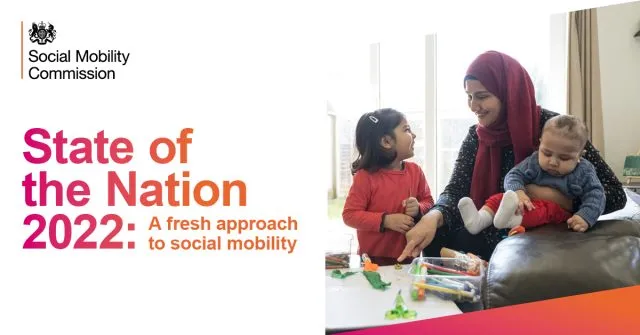The Social Mobility Commission (SMC) reports on where mobility is working well, alongside areas of concern, in its 2022 annual report, State of the Nation: A fresh approach to social mobility.
The report unveils a new Social Mobility Index, which will give a much more systematic way of measuring social mobility across the whole of the UK. Data will be compared annually – and at longer intervals of 5 or 10 years – to show trends in social mobility, including by place and protected characteristics such as sex, ethnicity and disability.
It highlights that the picture for social mobility is not as negative as thought, especially when mobility is reviewed over the long term. Almost every gap in intermediate outcomes between young people from higher and lower socio-economic backgrounds has narrowed in the past decade, for example. There are still disparities, but there has been progress across the board.
Key findings:
- There are still more people moving upward, to a higher occupational level than their parents, than people moving downward. But this surplus is smaller than before. This is largely because the professional class has grown in the last 70 years, so there are more people already starting at the top, where moving further upwards is not possible.
- The relative chances of people from different occupational backgrounds reaching higher-level jobs have not worsened over the decades, and may even have improved.
- The gap in educational performance between disadvantaged and non-disadvantaged children aged 11 was around 13% smaller in 2019 than in 2011. We will need to monitor how the impact of Covid-19 might affect this in future years.
- However, significant gaps remain. In the 2020 to 2021 academic year, only 31.7% of disadvantaged pupils achieved a grade 5 or above in GCSE English and Maths compared with 59.2% of all other pupils. This also means that two-thirds of disadvantaged pupils and more than a third of all other pupils fail to achieve a strong pass in both English and Maths at GCSE.
- The gaps between professional and working-class backgrounds for both university participation and degree attainment also narrowed between 2014 and 2021.
- The rate of young people from working-class backgrounds not in employment, education or training (NEET) has decreased since 2014 and was the lowest reported on record in 2021 at 12.4%. The gap between class backgrounds has also narrowed.
- The gap in current occupational levels has also narrowed. In 2014, men aged 25 to 29 from a professional background were 1.9 times more likely to be in a professional job than men from a working-class background. By 2021, this dropped to 1.6 times more likely. For women, the drop was from 2.3 times more likely to 1.6 times more likely.
The report highlights important areas of focus for the Commission going forward: an improved understanding of the impact of families and culture on mobility outcomes, as well as better data overall, to avoid elaborate guesswork. This includes data harmonisation across the 4 nations.
